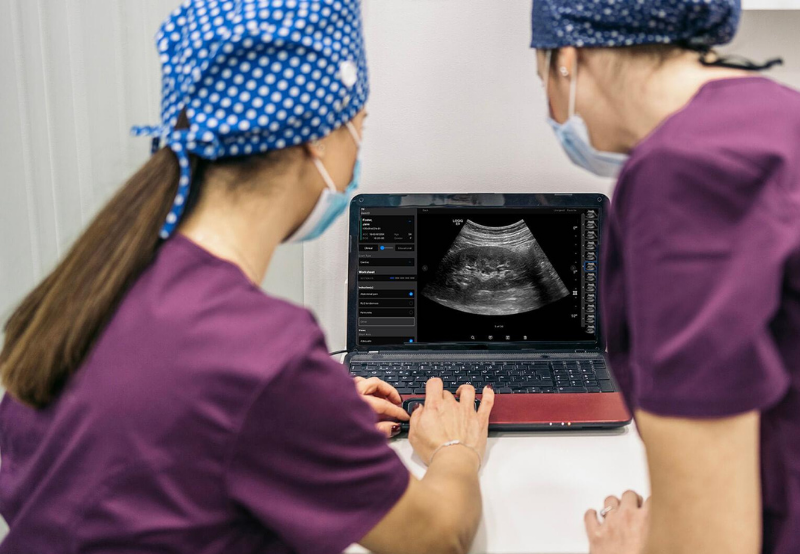Press Release
Exo Raises $220 Million As Hand-Held Ultrasound Race Heats Up

As the race to be the first to provide hand-held ultrasound heating up, Exo has come out on top with its latest investment round of $220 million. We’ll examine what this means for the industry and how this could benefit healthcare providers and patients alike.
The Growing Trend of Handheld Ultrasound Devices
The use of handheld ultrasound devices is becoming more and more common among medical professionals. There are many reasons for this growing trend. First, handheld ultrasound devices are becoming more and more affordable. Second, they are much easier to use than traditional ultrasound machines. Third, the quality of the images produced by handheld ultrasound devices is improving all the time.
There are many different types of handheld ultrasound devices on the market today. Some of the most popular brands include the SonoSite M-Turbo, GE Vscan, Philips CX50, and Toshiba Nemio. Each of these brands has its own strengths and weaknesses. However, all of them offer a great way for medical professionals to get high-quality images without having to lug around a full-sized ultrasound machine.
One of the biggest advantages of handheld ultrasound devices is that they are much cheaper than traditional ultrasound machines. The SonoSite M-Turbo, for example, costs around $30,000. That may seem like a lot of money, but it’s actually very affordable when you compare it to the cost of a traditional machine, which can easily run into the hundreds of thousands of dollars.
Another big advantage of handheld ultrasound devices is that they are much easier to use than their larger counterparts. Most models only require one person to operate them, which makes them ideal for busy medical practices. Additionally, many models come with built-in software that makes it easy to get high-quality images without any
Changing Trends in Handheld Ultrasound Devices
The popularity of handheld ultrasound devices has grown in recent years, as has the number of companies producing them. Exo, a startup that makes a hand-held ultrasound device, has raised $8 million in funding to help it compete in this rapidly growing market.
Handheld ultrasound devices are becoming increasingly popular due to their portability and affordability. Their small size means they can be easily carried around and used in a variety of settings, including primary care offices, urgent care clinics, and even at home.
Their affordability is also making them more popular. Prices for handheld ultrasound devices have come down significantly in recent years, making them more accessible to a wider range of users.
Exo’s device is called the OmniScan, and it’s designed to be used by both medical professionals and consumers. The company plans to use the funding to further develop its product and expand its marketing efforts.
With more companies entering the market and competition increasing, prices for handheld ultrasound devices are likely to continue to fall. This will make them even more popular and allow more people to benefit from their use.
Exo Aipowered 220m $220 million
In May 2014, Exo raised $220 million in a Series B round of funding led by Kleiner Perkins Caufield & Byers. The company has now raised a total of $340 million.
Exo is developing a hand-held ultrasound device that it says will be much cheaper and easier to use than current devices on the market. The company was founded in 2012 by Mehmet Yigit (CEO) and Miki Kuwabara (COO), who met while working at getUWired, a web design company.
The funding will be used to continue developing the product, as well as to expand the team and build out the sales and marketing infrastructure. Exo is currently available for pre-order, with shipping expected to begin in late 2014 or early 2015.
What are Some of the Main Features of Exo’s Device?
Some of the main features of Exo’s device include its portability, affordability, and accuracy. The device is about the size of a smartphone and can be easily carried in a pocket or purse. It uses sensors to detect sound waves and then sends the data to an app on a connected device, such as a smartphone or tablet. The app then displays the images on a screen for the user to see.
The device is said to be much more affordable than traditional ultrasound machines, which can cost tens of thousands of dollars. Exo plans to sell its devices for around $2,000. The company says that its technology is also more accurate than other portable ultrasound devices on the market.
How to Navigate Challenges Faced by Handheld Ultrasound User?
There is no question that handheld ultrasound devices have revolutionized medical care. But as with any new technology, there are challenges that need to be addressed. Here are some tips on how to navigate the challenges faced by handheld ultrasound users:
1. Make sure you have a good understanding of the anatomy and physiology of the body part you are scanning. This will help you to better identify abnormalities and avoid potential errors.
2. Be aware of potential artifacts that can occur during scanning. These can include shadowing, reverberation, and side lobe artifacts.
3. Use patient positioning techniques to optimize image quality. This includes using proper bedding, pillows, and positioning pads.
4. Understand the limitations of your device. Do not attempt to scan beyond the capabilities of your machine or software application.
5. Stay up-to-date on advances in technology and software updates. This will help you make the most of your device and ensure that you are using it in the most effective way possible
RIS Review
Exo is on a mission to make ultrasound more accessible, affordable, and portable. The company has raised $10 million in seed funding to bring its hand-held ultrasound device to market.
The Exo ultrasound is designed for use in primary care settings and is FDA cleared for 13 applications including abdominal, cardiac, and obstetric imaging. The device has a suggested retail price of $9,995 and will be available in the US later this year.
The Exo ultrasound is unique in its design and pricing, but it’s not the only player in the hand-held ultrasound market. SonoSite, GE Healthcare, Philips Healthcare, and Siemens Healthineers all offer handheld ultrasounds that range in price from $5,000 to $20,000.
The hand-held ultrasound market is growing as demand increases for point-of-care diagnostic tools. This type of ultrasound can be used to quickly and easily diagnose a variety of conditions without the need for a traditional cart-based system.
With its competitive pricing and easy-to-use design, the Exo ultrasound has the potential to disrupt the hand-held ultrasound market.
Press Release
Benefits of Using a Software Application for Doctor Online Reputation Management

For this reason, a lot of people are beginning to use software to manage their internet business reputation. This is done to make sure they have all the information they require about a clinic, hospital, or other establishment before taking a person there. However, patients must use this software package in order for this to happen. to ensure that they are providing reviews and compliments for the technique they examined. All of these advantages and benefits come from using this monitoring software application for your clinical procedure or company.
It encourages the marketing of a facility or clinical practise.
The fact that it encourages the marketing of the medical practise or establishment is one of the most important reasons why using online reputation monitoring in the healthcare industry is a great idea. However, this will only help the company if you receive positive reviews, recommendations, and comments.
It promotes advertising and marketing because the software will make it much easier for people to find the practise online if they are looking for it. After that, they may choose if this is something they should consider employing or not. However, it will also include negative remarks and also evaluations.
letting your patients know how your practise is doing
When you employ physician internet reputation monitoring software, you can be sure that you are telling your clients the truth about your practise. enabling them to express exactly how they perceive the technique or clinic in their own words. And they believe that what they believe can change the approach to make it much better for the patients.
Because you aren’t the one waiting in the waiting room, this is a great concept. In addition, they might have access to information that you do not. Giving your people a voice in your strategy can be a smart idea because of this. When they create an online evaluation, they can accomplish this.
Make it easier for others to find you online.
Generally speaking, this benefit is the same as the marketing and advertising benefit. Due to the doctor’s online reputation monitoring software, specifically a Google search, people can find your approach online. making it simpler for new customers to find your approach.
However, they will also find this to be simpler if you receive a lot of negative feedback. This is why, if any of your current patients are leaving comments, you need to make sure they are all good. Regardless of whether there are techniques that can’t be found online, this can help or hurt your practise.
provides a mechanism for you to communicate with people
It gives you a way to communicate with people thanks to the medical online Amazeful reputation management software. Make sure potential customers can tell that you genuinely value your clients’ experiences in your waiting area and with your service.
The only thing to keep in mind is that, under any circumstances, you should never comment negatively on someone. The only thing that can determine whether you’ll get new patients or not is what you do.
enabling you to improve the flaws in your approach.
Press Release
You become infected with RedLine malware through fake Windows 11 upgrade installers.

Users of Windows 10 have begun to get phoney Windows 11 upgrade installers, tricking them into downloading and running RedLine stealer software.
The attacks took place at the same time that Microsoft announced the broad deployment phase for Windows 11. As a result, the attackers were well-prepared for this move and waited for the ideal time to maximise the effectiveness of their operation.
As the most extensively used password, browser cookie, credit card, and cryptocurrency wallet information thief at the moment, RedLine stealer infections can have serious negative effects on the victims.
The initiative
The attackers exploited the “windows-upgraded.com” domain for the malware distribution portion of their campaign, according to HP experts who have detected this effort.
When a visitor selected the “Download Now” button on the website, a 1.5 MB ZIP archive with the name “Windows11InstallationAssistant.zip” was downloaded directly from a Discord CDN. The website looks to be an official Microsoft website.
Decompressing the file yields a folder with a size of 753MB and a remarkable compression ratio of 99.8%, which was made possible by the executable’s inclusion of padding.
An encoded parameter starts a PowerShell process when the victim runs the programme in the folder.
A.jpg file is then retrieved from a distant web server when a cmd.exe process with a 21-second timeout has finished running.
The DLL in this file is organised in reverse, maybe to avoid detection and analysis.
The first process then loads the DLL and swaps it out for the current thread context. That DLL is a RedLine stealer payload that uses a TCP connection to communicate with the command-and-control server to receive instructions on what malicious operations should be performed next on the recently compromised system.
Outlook
Nothing prevents the actors from registering a new domain and continuing their campaign even though the distribution site is currently unavailable. In fact, it’s quite likely that this is already taking place in nature.
Due to hardware compatibility issues, many Windows 10 customers are unable to download Windows 11 via the official distribution channels. Malware operators see this as a great opportunity to recruit new victims.
The strategies disclosed by HP are not surprising at this time, as threat actors are also use Windows’ legitimate update clients to execute malicious code on compromised Windows systems, as BleepingComputer discovered in January.
Remember that these risky websites are advertised through forum postings, posts on social media, and instant messages, so only rely on the official Windows upgrade system alerts.
Press Release
THE ANALYSIS RESULTS THAT THE OPENCV-BASED FACIAL RECOGNITION MODEL AS USED BY EXAM MONITORIO FAILS TO RECOGNIZE BLACK FACES MOST OF THE TIME (TODD FEATHERS/VICE).

Analysis finds that an OpenCV-based facial recognition model used by exam monitoring software Proctorio fails to recognize Black faces more than 50% of the time — A student researcher has reverse-engineered the controversial exam software—and discovered a tool infamous for failing to recognize non-white faces.
-

 Social Media10 months ago
Social Media10 months agoWho is Rouba Saadeh?
-

 Apps10 months ago
Apps10 months agoWhy is Everyone Talking About Hindi Keyboards?
-

 Social Media10 months ago
Social Media10 months agoMati Marroni Instagram Wiki (Model’s Age, Net Worth, Body Measurements, Marriage)
-

 Entertainment10 months ago
Entertainment10 months ago12 Online Streaming Sites that Serve as Best Alternatives to CouchTuner
-

 Apps10 months ago
Apps10 months agoThings you need to know about Marathi keyboard today
-

 Apps10 months ago
Apps10 months agoStuck with Your default Bangla keyboard? Isn’t it time for a change?
-

 Entertainment10 months ago
Entertainment10 months agoMovierulz Website: Movierulzz 2021 Latest Movies on Movierulz.com
-

 Social Media10 months ago
Social Media10 months agoBrooke Daniells: Everything About Catherine Bell’s Partner
